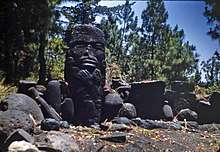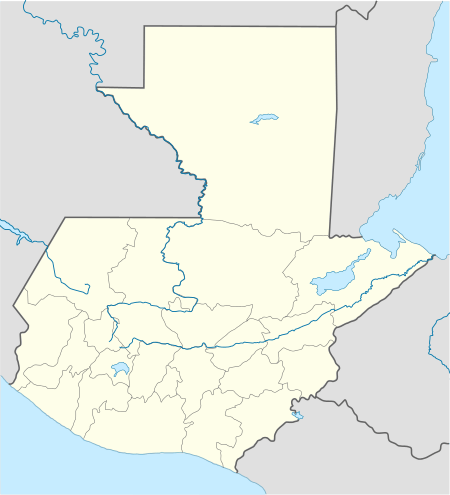Pascual Abaj
Pascual Abaj (alternatively written Pascual Ab'aj),[1] also known as Turcaj,[2] Turk'aj,[3] Turuk'aj and Turukaj,[4] is a pre-Columbian Maya idol at Chichicastenango that survived the Spanish conquest of Guatemala and which is still venerated by the local community. It is the best-known example of such an image.[5] The image was badly damaged in the 1950s by members of Catholic Action.[6]
| Pascual Abaj | |
|---|---|
Turcaj / Turk'aj / Turuk'aj / Turukaj | |
 The statue in 1948, before it was defaced | |
| Religion | |
| Affiliation | Maya religion |
| District | Quiché Department |
| Region | Guatemalan Highlands |
| Deity | Rey Pascual |
| Location | |
| Municipality | Chichicastenango |
| Country | Guatemala |
 Location in Guatemala | |
| Geographic coordinates | 14.936858°N 91.114675°W |
History
.jpg)
After the Spanish conquest, the stone figure is said to have been carried away from a site in the village of Chichicastenango and reset upon the hill so offerings could be made away from the vigilance of the Catholic Church and the Spanish colonists.[2]
Before it was defaced, the statue was described as a grotesque human figure with a large head and high, pointed forehead. It had two circular earspools in line with its mouth; its arms were crossed on its chest, with the fingers extended. A cord was sculpted around its waist, to which was attached the image of an inverted severed human head. It stood approximately 1 metre (3.3 ft) high. An observer in the 1950s noted that the figure appeared to have been buried sometime in the past.[4]
Traditional Maya shamans regularly perform ceremonies at the shrine, by day and night.[3] The statue is set upon a small altar surrounded by offerings, which include pine branches, crosses, flowers, copal resin, and items crafted from stone.[3] The shrine has now become a popular tourist attraction where visitors witness traditional Maya ceremonies.[7]
Location
The shrine is located upon a wooded ridge overlooking the Chichicastenango valley,[8] approximately 3 kilometres (1.9 mi) south of the town.[9] The statue is set on a small plateau amongst pine forest.[4]
Etymology
Abaj means "stone" in several contemporary highland Maya languages, including K'iche' and Kaqchikel,[10] while Pascual means "Easter" in Spanish.[11] "King Pascual" has been recorded as the subject of veneration since at least the 19th century.[10] Turcaj (spelled Turk'aj in modern Maya orthography) is the K'iche' name for the hill upon which the shrine is located.[3]
See also
Notes
- Ventura Peliz 2007, p. 64.
- Hart 2008, p. 81.
- Carmack 2001, p. 445.
- Rodríguez Rouanet et al 1993, p. 18.
- Früsorge 2015, p. 178.
- Hart 2008, p. 82.
- Hart 2008, pp. 81–82.
- Chládek 2011, p. 98.
- Ventura Peliz 2007, p. 64. Cook, Offit, and Taube 2013, p. 145.
- McDougall 1946, 2011, p. 248.
- Span¡shD!ct.
References
- Carmack, Robert M. (2001). Kik'ulmatajem le K'iche'aab': Evolución del Reino K'iche' (in Spanish). Guatemala: Iximulew. ISBN 99922-56-22-2. OCLC 253481949.
- Chládek, Stanislav (2011) Exploring Maya Ritual Caves: Dark Secrets from the Maya Underworld Lanham, Maryland, US: Rowman Altamira. ISBN 9780759119871. OCLC 741455505.
- Cook, G. W.; T. A. Offit, T. A.; and R. Taube (2013). "The Dynamics of Contemporary: Maya Religious Tradition: Agency and Structure in Selected Case Studies" in Indigenous Religion and Cultural Performance in the New Maya World. Albuquerque, New Mexico, US: University of New Mexico Press. ISBN 9780826353191. OCLC 848918202. – via Project MUSE (subscription required)
- Früsorge, Lars (2015) "Sowing the stone: sacred geography and cultural continuity. Economy among the Highland Maya of Guatemala." Estudios de cultura maya 45: 171–189. Mexico City, Mexico: Instituto de Investigaciones Filólogicas, Universidad Nacional Autónoma de México. ISSN 2448-5179.
- Hart, Thomas (2008) The Ancient Spirituality of the Modern Maya. Albuquerque, New Mexico, US: University of New Mexico Press. ISBN 9780826343505. OCLC 609225980.
- McDougall, Elsie (2011) [1946] "Observations on Altar Sites in the Quiche Region, Guatemala" Notes on Middle American Archaeology and Ethnology 62: 243–249. Boulder, Colorado, US: University Press of Colorado. – via Project MUSE (subscription required)
- Rodríguez Rouanet, Francisco; Edwin Soto; Fernando Seijas; Gerardo Townson Rincón (1993). Quiché. Colección Monografías de Guatemala 12 (in Spanish). Guatemala: Banco Granai & Townson, S.A. OCLC 32156736.
- Span¡shD!ct. www.spanishdict.com. Curiosity Media. Retrieved 2017-12-01.
- Ventura Peliz, Sebastiana Elizabeth (April 2007) El turismo en Guatemala; análisis económico jurídico y social del turismo en Santo Tomás Chichicastenango, departamento del Quiché. Guatemala City, Guatemala: Universidad de San Carlos de Guatemala: Facultad de Ciencias Jurídicas y Sociales. Retrieved 2017-12-03. Archived from the original on 2017-12-03. (in Spanish)
| Wikimedia Commons has media related to Pascual Abaj. |